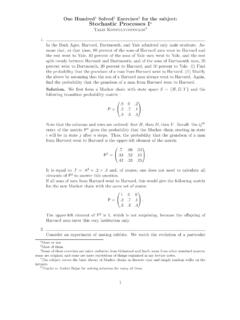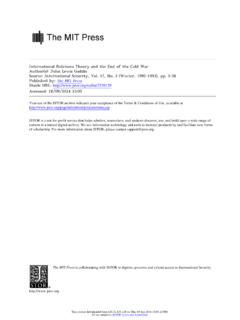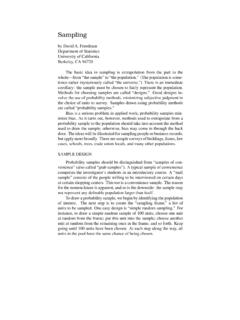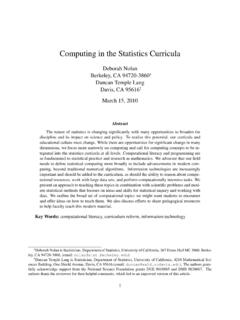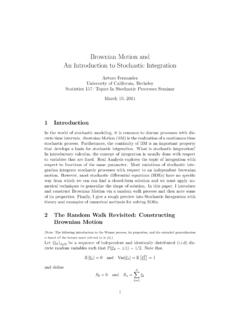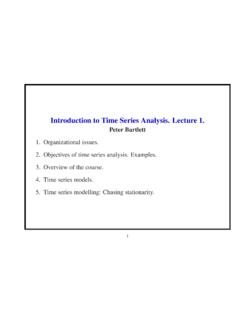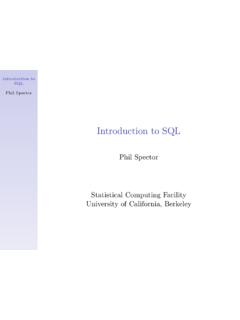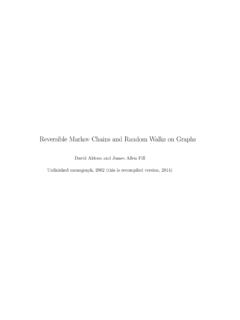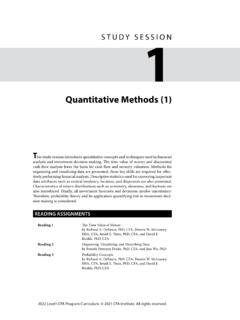Transcription of 1 RANDOM FORESTS - University of California, Berkeley
1 1 RANDOM FORESTS Leo BreimanStatistics Department University of California Berkeley , CA 94720 January 2001 AbstractRandom FORESTS are a combination of tree predictorssuch that each tree depends on the values of a randomvector sampled independently and with the samedistribution for all trees in the forest. Thegeneralization error for FORESTS converges to a limitas the number of trees in the forest becomes generalization error of a forest of tree classifiersdepends on the strength of the individual trees in theforest and the correlation between them. Using arandom selection of features to split each node yieldserror rates that compare favorably to Adaboost(Freund and Schapire[1996]), but are more robust withrespect to noise. Internal estimates monitor error,strength, and correlation and these are used to showthe response to increasing the number of features usedin the splitting.
2 Internal estimates are also used tomeasure variable importance. These ideas are alsoapplicable to RANDOM IntroductionSignificant improvements in classification accuracy have resulted from growingan ensemble of trees and letting them vote for the most popular class. In orderto grow these ensembles, often RANDOM vectors are generated that govern thegrowth of each tree in the ensemble. An early example is bagging (Breiman[1996]), where to grow each tree a RANDOM selection (without replacement) ismade from the examples in the training example is RANDOM split selection (Dietterich [1998]) where at each nodethe split is selected at RANDOM from among the K best splits. Breiman [1999]generates new training sets by randomizing the outputs in the original trainingset. Another approach is to select the training set from a RANDOM set of weightson the examples in the training set. Ho [1998] has written a number of papers on"the RANDOM subspace" method which does a RANDOM selection of a subset offeatures to use to grow each an important paper on written character recognition, Amit and Geman [1997]define a large number of geometric features and search over a RANDOM selectionof these for the best split at each node.
3 This latter paper has been influential inmy common element in all of these procedures is that for the kth tree, arandom vector k is generated, independent of the past RANDOM vectors 1, .. , k 1 but with the same distribution; and a tree is grown using the trainingset and k, resulting in a classifier h(x, k) where x is an input vector. Forinstance, in bagging the RANDOM vector is generated as the counts in Nboxes resulting from N darts thrown at RANDOM at the boxes, where N isnumber of examples in the training set. In RANDOM split selection consists of anumber of independent RANDOM integers between 1 and K. The nature anddimensionality of depends on its use in tree a large number of trees is generated, they vote for the most popular call these procedures RANDOM A RANDOM forest is a classifier consisting of a collection of tree-structured classifiers {h(x, k),k=1.}
4 } where the { k} are independent identicallydistributed RANDOM vectors and each tree casts a unit vote for the most popular class atinput x . Outline of PaperSection 2 gives some theoretical background for RANDOM FORESTS . Use of theStrong Law of Large Numbers shows that they always converge so thatoverfitting is not a problem. We give a simplified and extended version of the3 Amit and Geman [1997] analysis to show that the accuracy of a RANDOM forestdepends on the strength of the individual tree classifiers and a measure of thedependence between them (see Section 2 for definitions).Section 3 introduces FORESTS using the RANDOM selection of features at each nodeto determine the split. An important question is how many features to select ateach node. For guidance, internal estimates of the generalization error,classifier strength and dependence are computed. These are called out-of-bagestimates and are reviewed in Section 4.
5 Sections 5 and 6 give empirical resultsfor two different forms of RANDOM features. The first uses RANDOM selectionfrom the original inputs; the second uses RANDOM linear combinations of results compare favorably to results turn out to be insensitive to the number of features selected to spliteach node. Usually, selecting one or two features gives near optimum explore this and relate it to strength and correlation, an empirical study iscarried out in Section has no RANDOM elements and grows an ensemble of trees bysuccessive reweightings of the training set where the current weights depend onthe past history of the ensemble formation. But just as a deterministic randomnumber generator can give a good imitation of randomness, my belief is that inits later stages Adaboost is emulating a RANDOM forest. Evidence for thisconjecture is given in Section recent problems, medical diagnosis and document retrieval ,often have the property that there are many input variables, often in thehundreds or thousands, with each one containing only a small amount ofinformation.
6 A single tree classifier will then have accuracy only slightly betterthan a RANDOM choice of class. But combining trees grown using randomfeatures can produce improved accuracy. In Section 9 we experiment on asimulated data set with 1,000 input variables, 1,000 examples in the training setand a 4,000 example test set. Accuracy comparable to the Bayes rate is many applications, understanding of the mechanism of the RANDOM forest"black box" is needed. Section 10 makes a start on this by computing internalestimates of variable importance and binding these together by reuse 11 looks at RANDOM FORESTS for regression. A bound for the meansquared generalization error is derived that shows that the decrease in errorfrom the individual trees in the forest depends on the correlation betweenresiduals and the mean squared error of the individual trees. Empirical resultsfor regression are in Section 12.
7 Concluding remarks are given in Section Characterizing the Accuracy of RANDOM RANDOM FORESTS Converge4 Given an ensemble of classifiers h1(x),h2(x), .. ,hK(x), and with the training setdrawn at RANDOM from the distribution of the RANDOM vector Y,X, define themargin function asmg(X,Y)=avkI(hk(X)=Y) maxj YavkI(hk(X)=j).where I( ) is the indicator function. The margin measures the extent to whichthe average number of votes at X,Y for the right class exceeds the average votefor any other class. The larger the margin, the more confidence in theclassification. The generalization error is given byPE*=PX,Y(mg(X,Y)<0)where the subscripts X,Y indicate that the probability is over the X,Y RANDOM FORESTS , hk(X)=h(X, k). For a large number of trees, it follows fromthe Strong Law of Large Numbers and the tree structure that:Theorem As the number of trees increases, for almost surely all sequences 1, ..PE* converges toPX,Y(P (h(X, )=Y) maxj YP (h(X, )=j)<0) (1)Proof: see Appendix result explains why RANDOM FORESTS do not overfit as more trees are added,but produce a limiting value of the generalization Strength and CorrelationFor RANDOM FORESTS , an upper bound can be derived for the generalization errorin terms of two parameters that are measures of how accurate the individualclassifiers are and of the dependence between them.
8 The interplay betweenthese two gives the foundation for understanding the workings of randomforests. We build on the analysis in Amit and Geman [1997].Definition The margin function for a RANDOM forest is mr(X,Y)=P (h(X, )=Y) maxj YP (h(X, )=j) (2)and the strength of the set of classifiers {h(x, )} is s=EX,Ymr(X,Y) (3)5 Assuming s 0, Chebychev s inequality gives PE* var(mr)/s2 (4)A more revealing expression for the variance of mr is derived in the following:Let j(X,Y)=arg maxj YP (h(X, )=j)somr(X,Y)=P (h(X, )=Y) P (h(X, )= j(X,Y)) =E [I(h(X, )=Y) I(h(X, )= j(X,Y))].Definition The raw margin function isrmg( ,X,Y)=I(h(X, )=Y) I(h(X, )= j(X,Y)).Thus, mr(X,Y) is the expectation of rmg( ,X,Y) with respect to . For anyfunction f the identity[E f( )]2=E , 'f( )f( ')holds where , ' are independent with the same distribution, implying thatmr(X,Y)2=E , 'rmg( ,X,Y)rmg( ',X,Y) (5)Using (5) gives var(mr)=E , '(covX,Yrmg( ,X,Y)rmg( ',X,Y)) =E , '( ( , ')sd( )sd( ')) (6)where ( , ') is the correlation betweenrmg( ,X,Y)andrmg( ',X,Y) holding , ' fixed and sd( ) is the standard deviation of rmg( ,X,Y) holding ,var(mr)= (E sd( ))2 (7) E var( )where is the mean value of the correlation; that is,6 =E , '( ( , ')sd( )sd( '))/E , '(sd( )sd( ')) WriteE var( ) E (EX,Yrmg( ,X,Y))2 s2 1 s2.
9 (8)Putting (4), (7), and (8) together yields:Theorem An upper bound for the generalization error is given byPE* (1 s2)/s2 Although the bound is likely to be loose, it fulfills the same suggestive functionfor RANDOM FORESTS as VC-type bounds do for other types of classifiers. It showsthat the two ingredients involved in the generalization error for RANDOM forestsare the strength of the individual classifiers in the forest, and the correlationbetween them in terms of the raw margin functions. The c/s2 ratio is thecorrelation divided by the square of the strength. In understanding thefunctioning of RANDOM FORESTS , this ratio will be a helpful guide--the smaller it is,the The c/s2 ratio for a RANDOM forest is defined asc/s2= /s2 There are simplifications in the two class situation. The margin function ismr(X,Y)=2P (h(X, )=Y) 1 The requirement that the strength is positive (see (4)) becomes similar to thefamiliar weak learning condition EX,YP (h(X, )=Y)>.
10 5. The raw marginfunction is 2I(h(X, )=Y) 1 and the correlation is between I(h(X, )=Y)andI(h(X, ')=Y). In particular, if the values for Y are taken to be +1 and -1, then =E , '[ (h( , ),h( , ')]so that is the correlation between two different members of the forestaveraged over the , ' more than two classes, the measure of strength defined in (3) depends on theforest as well as the individual trees since it is the forest that determines j(X,Y).Another approach is possible. WritePE*=PX,Y(P (h(X, )=Y) maxj YP (h(X, )=j)<0) PX,Y(P (h(X, )=Y) P (h(X, )=j)<0)j .Definesj=EX,Y(P (h(X, )=Y) P (h(X, )=j))to be the strength of the set of classifiers {h(x, )} relative to class j. Note thatthis definition of strength does not depend on the forest. Using Chebyshev'sinequality, assuming all sj>0 leads to PE* var(j P (h(X, )=Y) P (h(X, )=j))/sj2 (9)and using identities similar to those used in deriving (7), the variances in (9) canbe expressed in terms of average correlations.)
